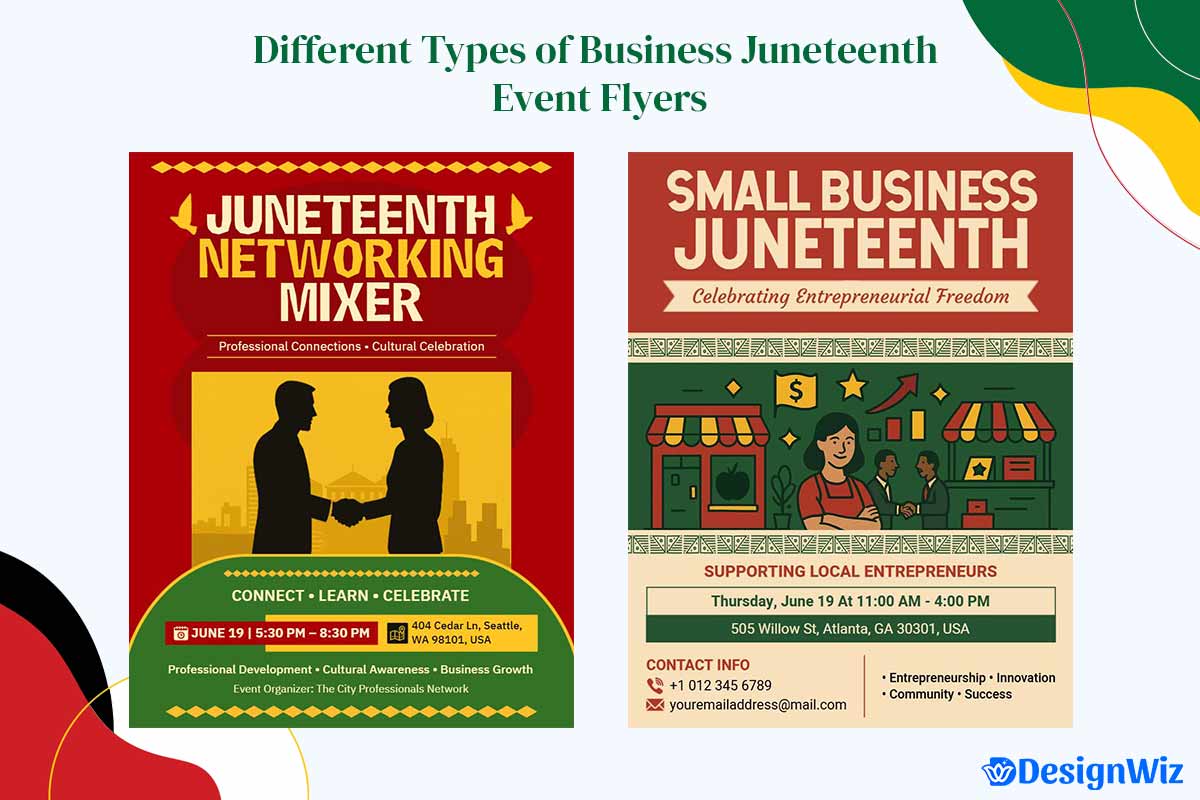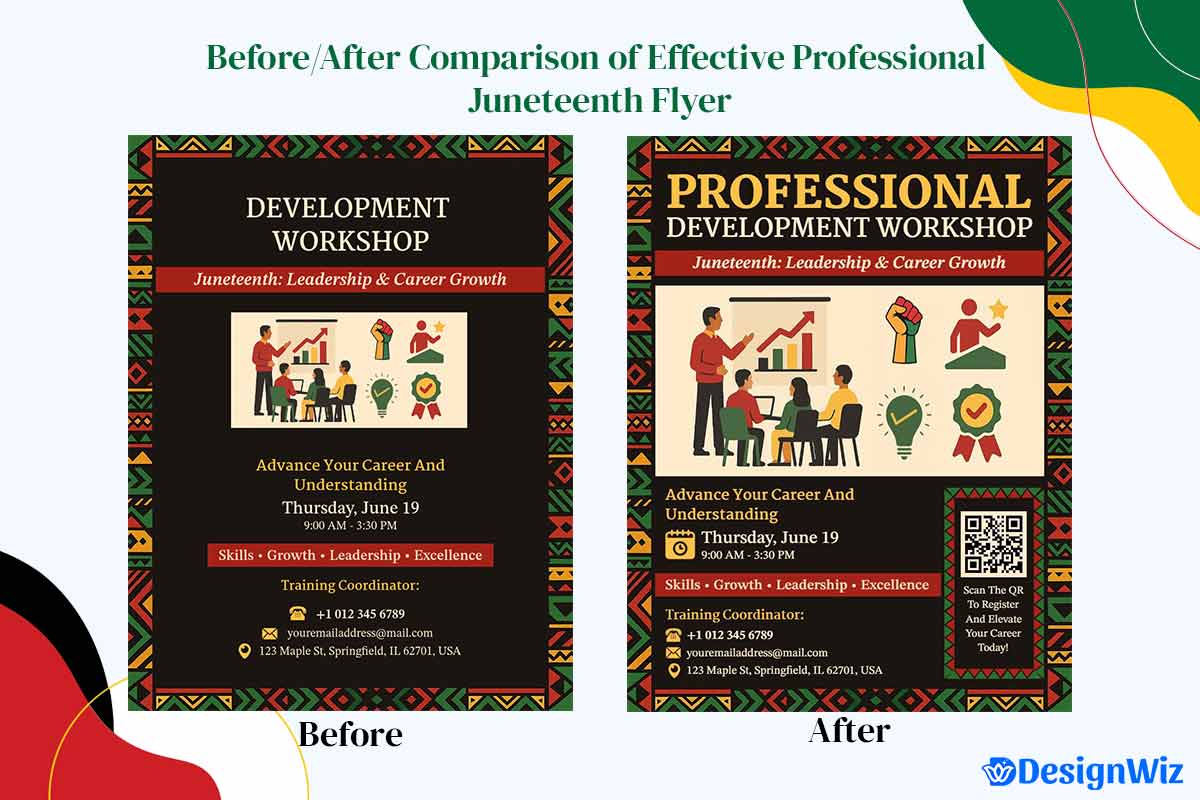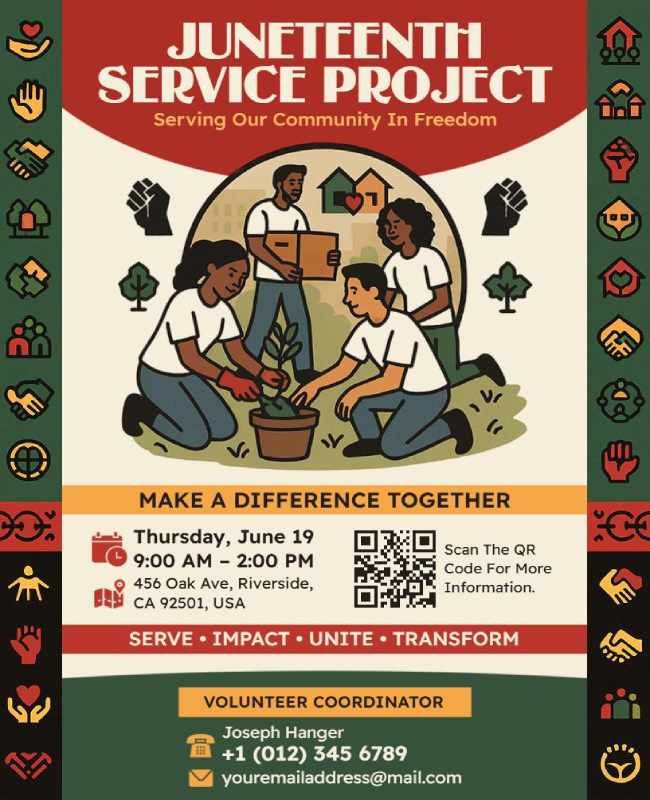Get ready-made flyer templates that make an impact—bold, respectful, and designed for Juneteenth events and outreach.
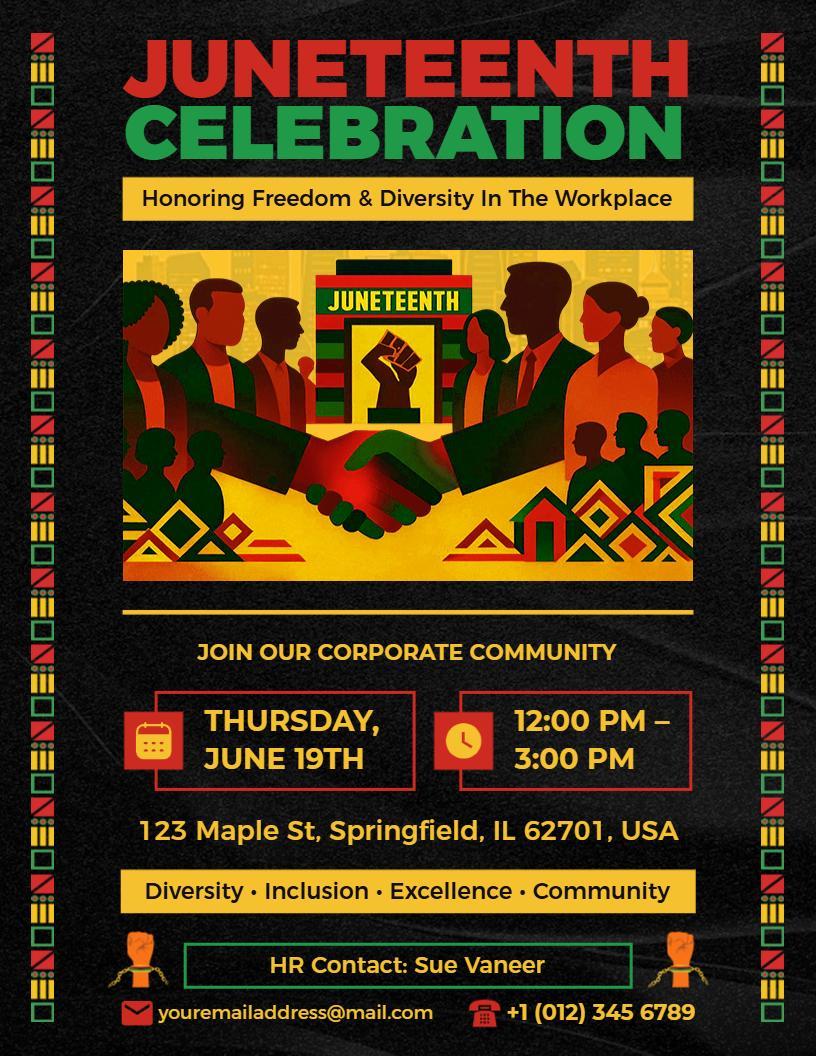
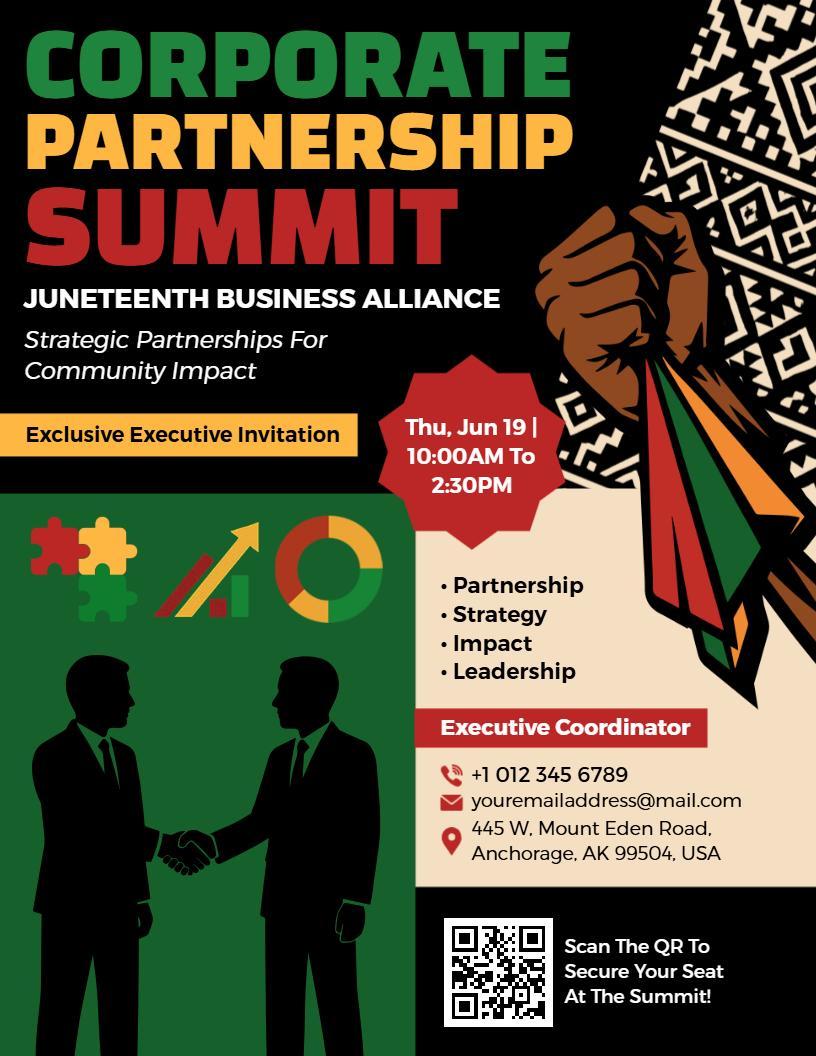

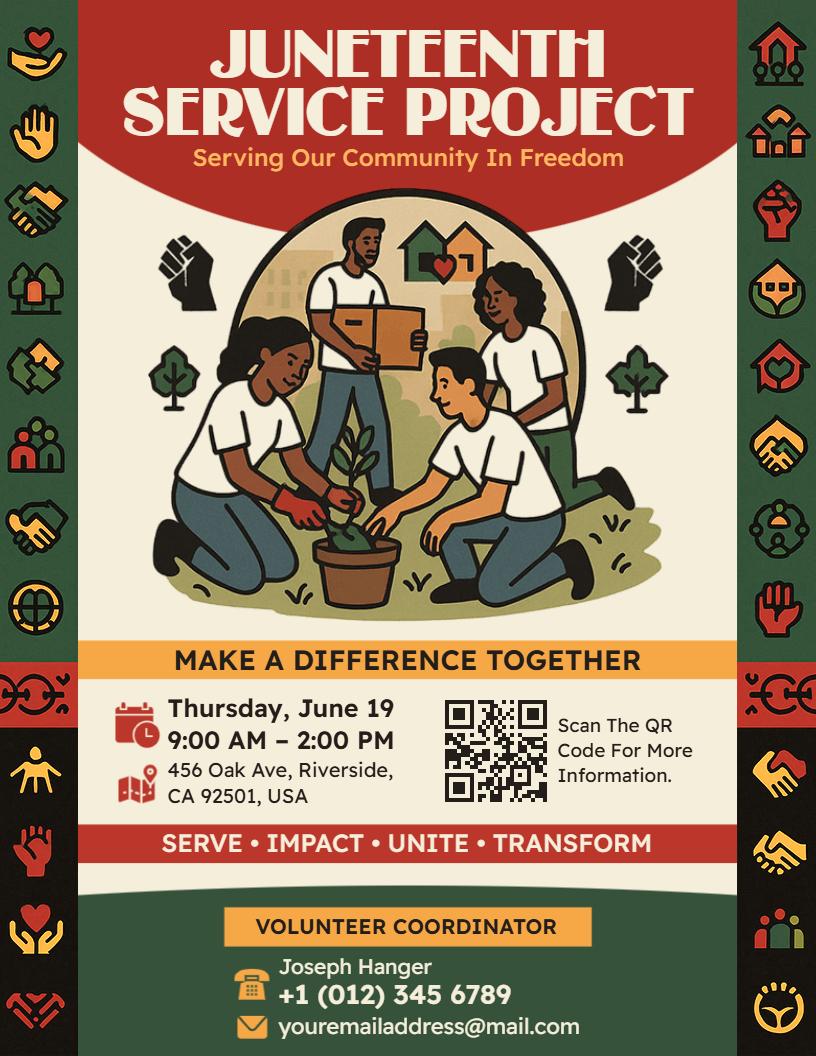
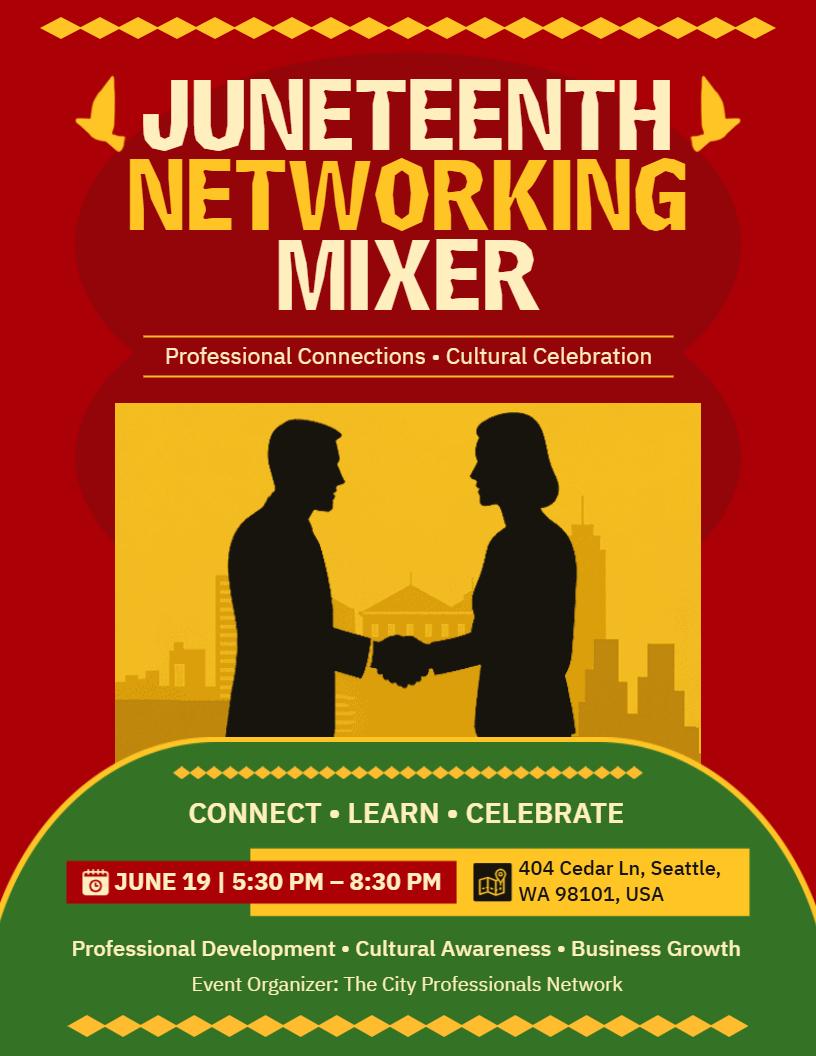
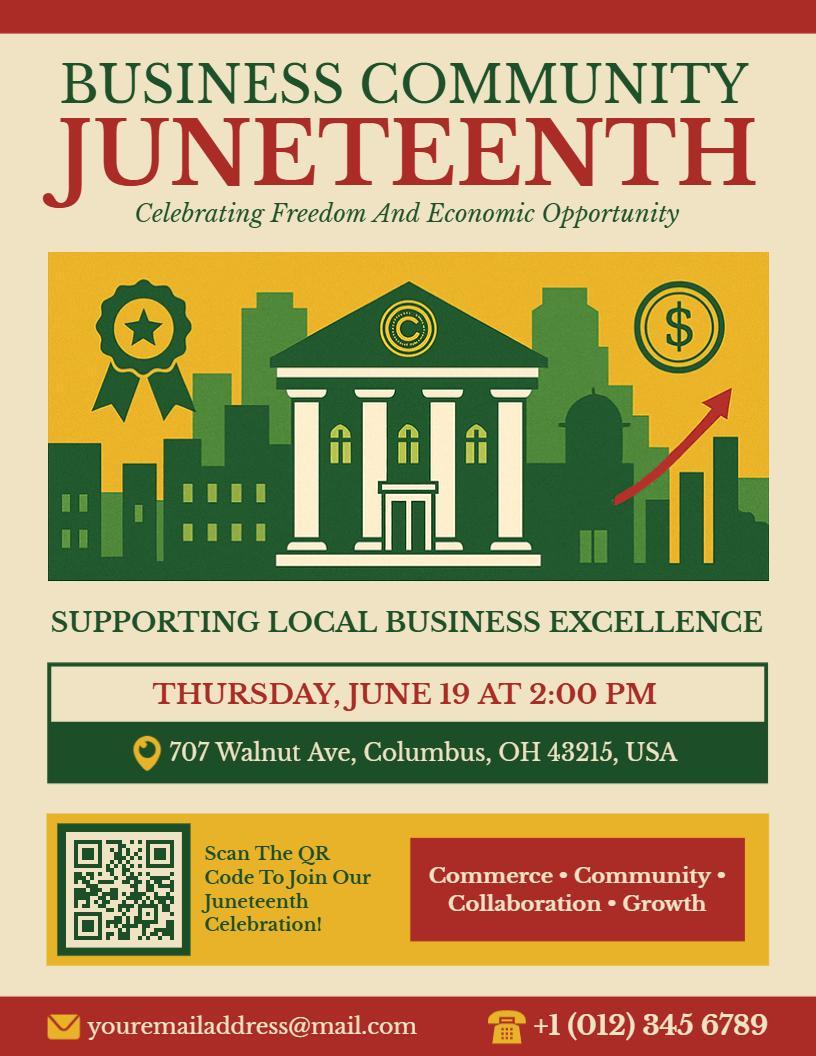
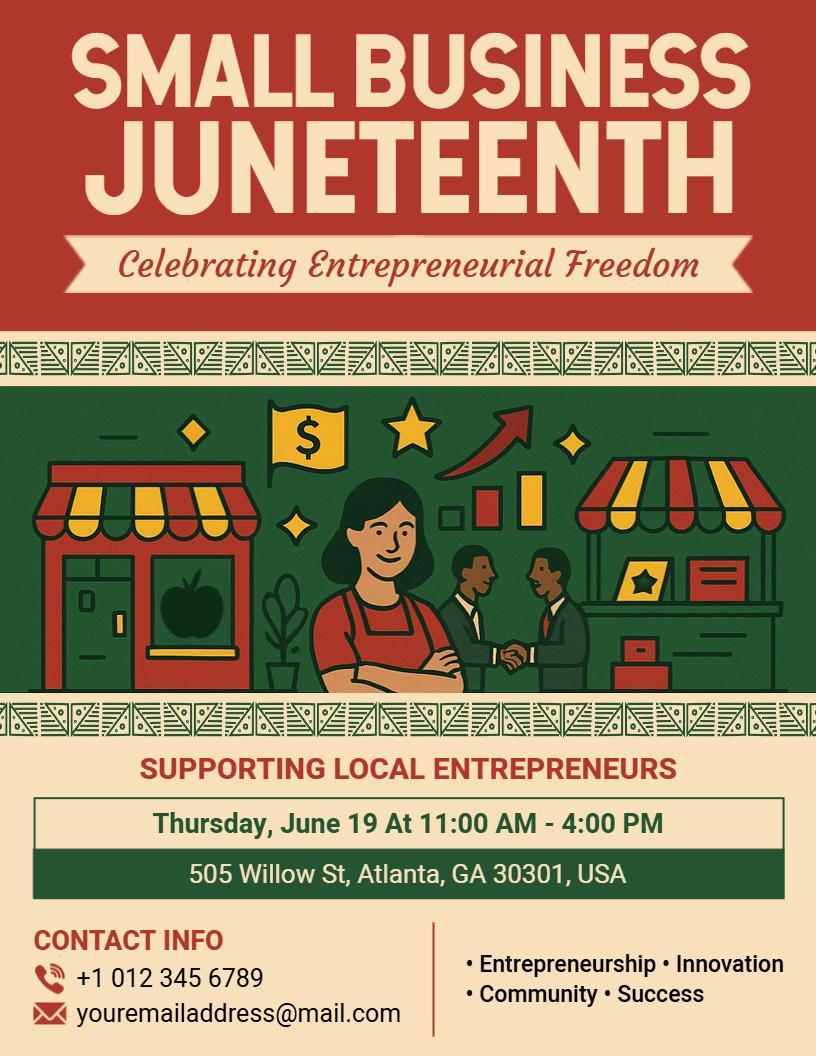

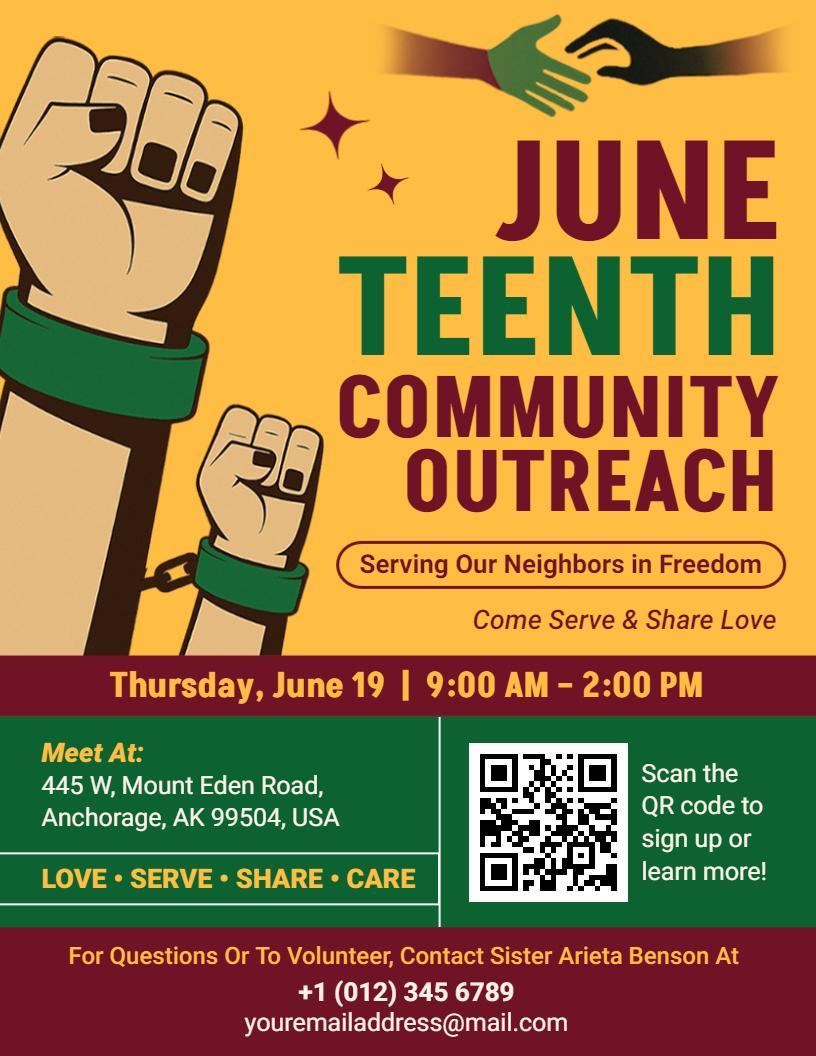
As corporate America increasingly recognizes Juneteenth as a federal holiday, organizations across sectors are grappling with how to create meaningful, authentic celebrations that honor the historical significance of June 19, 1865, while fostering genuine workplace inclusion and community engagement.
An effective Juneteenth business & nonprofit flyers balances organizational branding with cultural respect, communicates genuine commitment to diversity and inclusion rather than performative celebration, and provides clear information for both internal teams and external stakeholders while maintaining appropriate professional standards.
The challenge for business and nonprofit lies in creating promotional Juneteenth flyers that feel authentic and educational rather than opportunistic. This requires understanding both the historical context of Juneteenth and the contemporary workplace dynamics around diversity, equity, and inclusion (DEI) initiatives.
This comprehensive guide provides frameworks, templates, and best practices for creating professional Juneteenth business & nonprofit flyers that genuinely honor the holiday while supporting your organization’s commitment to meaningful inclusion. Explore our Complete Juneteenth flyer design guide for more foundational inspiration and visual best practices. Download our specialized Juneteenth Planning Checklist with organizational coordination tools and compliance guidelines.
Why Should Businesses and Nonprofits Observe Juneteenth?
Understanding the strategic and ethical imperatives behind organizational Juneteenth observance helps create more authentic and impactful celebrations.
Historical Significance in Professional Context
Juneteenth represents more than a historical commemoration, it embodies principles of freedom, resilience, and justice that align with contemporary organizational values around equity and inclusion. When enslaved people in Texas finally learned of their freedom on June 19, 1865, it marked not just legal emancipation but the beginning of ongoing struggles for economic opportunity, education access, and workplace equality.
Companies that thoughtfully connect Juneteenth to their ongoing diversity and inclusion efforts often find that employees are more engaged and responsive, compared to when the holiday is treated as a one-off observance.
DEI Initiatives and Strategic Alignment
Juneteenth observance supports multiple organizational objectives:
- Employee Resource Group (ERG) Activation: Provides meaningful programming opportunities for Black employee networks and multicultural ERGs
- Cultural Competency Development: Creates educational opportunities for all employees to understand American history and contemporary racial dynamics
- Community Engagement: Demonstrates organizational commitment to social justice and community partnership
- Talent Attraction and Retention: Shows prospective and current employees, particularly diverse talent, that the organization values inclusive culture
Corporate Responsibility and Community Connection
This section emphasizes how Juneteenth flyers can reflect your organization’s broader commitment to equity, community engagement, and meaningful corporate responsibility.
Modern organizational benefits include:
- Enhanced reputation among diverse customer bases
- Strengthened relationships with community organizations
- Improved employee satisfaction and cultural awareness
- Demonstration of authentic commitment to social justice beyond marketing initiatives
- Fully editable & printable
- Styles for brands, nonprofits, and local initiatives
- Perfect for promotions, awareness, and events
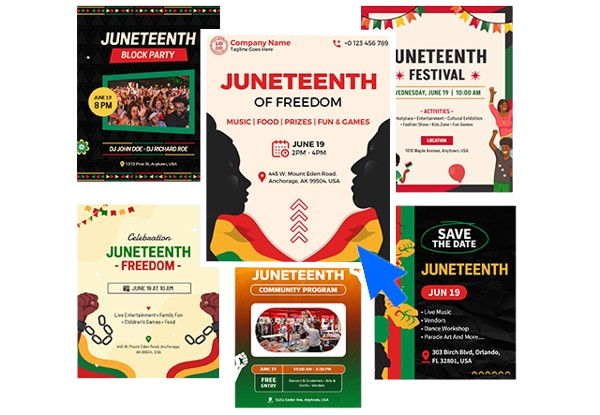
What Types of Business Juneteenth Celebrations Need Flyers?
Professional Juneteenth observances take various forms, each requiring different promotional approaches and messaging strategies.
Internal Employee Celebrations
These focus on building workplace culture and employee education. Using customized flyer templates aligned with internal branding ensures effective and cohesive communication across departments.
Design Considerations:
- Align with internal branding guidelines and communication standards
- Balance celebration with educational content
- Include information about employee resource groups and ongoing DEI initiatives
- Provide clear participation expectations and options
Typical Programming Elements:
- Lunch-and-learn educational sessions
- Panel discussions with community leaders or historians
- Cultural food experiences featuring traditional Juneteenth cuisine
- Employee storytelling and experience sharing sessions
According to Boston Children’s Hospital, the recognition of Juneteenth serves as an opportunity for African American employees to reflect on their history and fosters a sense of community and understanding within the workplace.1
Customer and Client-Facing Events
External celebrations that demonstrate organizational values to broader stakeholders:
Design Considerations:
- Professional but welcoming tone that appeals to diverse audiences
- Clear value proposition for attendance
- Brand consistency with marketing and communication standards
- Appropriate cultural sensitivity and educational framing
Typical Programming Elements:
- Community partnership showcases
- Business networking with diverse suppliers and vendors
- Public educational forums and speaker series
- Product or service launches with social justice themes
Learn More: Juneteenth Community Event Flyers Design Guide.
Community Engagement Initiatives
Collaborative events with local organizations and community groups:
Design Considerations:
- Partnership branding and co-sponsor recognition
- Community-accessible language and imagery
- Local cultural references and community connections
- Clear information about organizational community commitment
According to Northeastern University’s College of Social Sciences and Humanities, Juneteenth 2025 is commemorated through diverse community engagement initiatives across campuses, featuring events such as historical processions, cultural performances, and educational workshops that honor Black emancipation and promote community involvement.2
Educational Workshops and Professional Development
Skills-based or knowledge-focused programming for professional audiences:
Design Considerations:
- Academic or professional conference aesthetic
- Clear learning objectives and outcomes
- Professional development credit information
- Expert speaker credentials and topic expertise
Learn More: Juneteenth School & Educational Event Flyers Design Guide.
What Essential Elements Should Professional Juneteenth Flyers Include?
Juneteenth business & nonprofit flyers require careful balance between corporate communication standards and cultural authenticity. Here’s your comprehensive checklist:
Core Professional Information
This section outlines the key professional and logistical details your Juneteenth business or nonprofit flyer should include to ensure clarity, alignment, and impact.
Event Identity and Organizational Branding:
- Clear connection to Juneteenth with respectful, accurate historical context
- Organizational logo and branding consistent with company guidelines
- Event type and professional context clearly indicated
- Internal vs. external audience designation
Logistics and Professional Standards:
- Complete venue information including accessibility details
- Registration requirements and capacity limitations
- Professional dress code or attire guidance
- Time allocation for networking, learning, and follow-up
- Continuing education credits if applicable
Learning Objectives and Value Proposition:
- Clear educational or professional development outcomes
- Skills, knowledge, or awareness participants will gain
- Connection to broader organizational training or development goals
Organizational Context and Values Alignment
Ensure your flyer reflects your organization’s values and leadership support to reinforce the event’s relevance and credibility.
Mission Connection:
- Explicit link between Juneteenth observance and organizational values
- Connection to existing DEI initiatives and commitments
- Community partnership information and collaborative efforts
- Ongoing engagement opportunities beyond the single event
Leadership Endorsement:
- Executive sponsorship and leadership participation
- Quotes or statements from organizational leaders
- Connection to board-level diversity and inclusion commitments
Cultural and Educational Elements
Highlighting both cultural integrity and educational value, this section ensures your Juneteenth flyer promotes a respectful, informed, and inclusive event experience.
Historical Accuracy and Respect:
- Factually accurate information about June 19, 1865
- Appropriate cultural references without appropriation
- Educational components that enhance understanding
- Recognition of ongoing relevance and contemporary connections
Expert Content and Credible Sources:
- Qualified speakers and facilitators
- Academic or community partnerships
- Research-based content and historical documentation
- Diverse perspectives and voices in programming
How to Design Professional Juneteenth Flyers That Balance Celebration and Corporate Identity?
Creating Juneteenth business & nonprofit flyers that feel both professionally appropriate and culturally authentic requires strategic design choices that honor both organizational standards and Juneteenth’s significance. Create a flyer that seamlessly blends your brand’s identity with culturally respectful elements for a professional and impactful design.
Brand Guideline Integration
Maintain organizational visual identity while incorporating meaningful Juneteenth elements:
Color Palette Strategies:
- Integrate traditional Juneteenth colors (red, white, blue, green) with corporate brand colors
- Use corporate primary colors as base with Juneteenth accent colors
- Ensure sufficient contrast for accessibility compliance
- Consider color psychology in professional contexts
Typography and Corporate Standards:
- Use organizational standard fonts for headers and body text
- Maintain consistent font hierarchies according to brand guidelines
- Ensure readability across different professional contexts (email, print, digital displays)
- Balance visual interest with professional accessibility
Professional Imagery and Visual Elements
Select imagery that conveys both professionalism and cultural authenticity:
Photography Selection Guidelines:
- Use diverse professional settings and business contexts
- Include multigenerational and multicultural representation
- Avoid stereotypical or tokenistic imagery
- Focus on collaboration, learning, and professional development
Cultural Symbol Integration:
- Incorporate Juneteenth flag elements subtly within corporate design framework
- Use historical imagery appropriately and respectfully
- Include educational visual elements that enhance understanding
- Balance celebration with historical significance
Layout and Professional Communication Standards
Structure information according to business communication best practices:
Information Hierarchy:
- Lead with organizational context and value alignment
- Present educational content in scannable, professional format
- Use bullet points and clear sections for busy professional audiences
- Include clear calls-to-action and next steps
Professional Formatting:
- Maintain consistent margins and spacing according to brand guidelines
- Use professional layout grids and alignment
- Ensure mobile responsiveness for digital distribution
- Include proper legal disclaimers and accessibility statements
How to Create Meaningful Juneteenth Messaging for Business Contexts?
Authentic organizational messaging requires balancing respect for Juneteenth’s historical significance with genuine demonstration of contemporary workplace inclusion efforts.
Authentic Organizational Voice Development
Create messaging that reflects genuine organizational commitment:
Values-Based Language:
- Connect Juneteenth themes to specific organizational values and behaviors
- Use concrete examples of inclusion efforts rather than generic statements
- Acknowledge historical and contemporary challenges honestly
- Focus on learning and growth rather than performative celebration
Educational Framing:
- Position events as learning opportunities for all employees
- Include specific historical context and contemporary relevance
- Emphasize ongoing commitment beyond single-day observation
- Connect to broader DEI strategy and long-term goals
Avoiding Performative Celebration Pitfalls
Ensure your flyer messaging reflects genuine understanding by avoiding common mistakes that can undermine the purpose and impact of Juneteenth events.
Common messaging mistakes to avoid:
- Generic “diversity celebration” language without specific historical context
- Focus on organizational benefits without acknowledging historical significance
- Superficial symbol usage without educational content
- One-time event positioning without connection to ongoing efforts
Executive Leadership Messaging Integration
Develop consistent leadership voice around Juneteenth programming:
CEO and Senior Leadership Statements:
- Personal commitment to learning and organizational growth
- Specific actions the organization is taking beyond event programming
- Recognition of historical significance and contemporary relevance
- Invitation for all employees to engage in meaningful learning
Manager and Team Leader Guidance:
- Talking points for team discussions about Juneteenth significance
- Guidelines for inclusive team participation
- Resources for continued learning and development
- Connection to performance management and development goals
Last-Minute Business Juneteenth Planning Guide for 2025
Organizations that need to implement Juneteenth programming quickly can still create meaningful, authentic celebrations with focused planning and strategic resource allocation.
Quick Professional Implementation Strategies
Streamline planning without sacrificing authenticity or impact:
Partnership-Based Programming:
- Connect with local community organizations already planning Juneteenth events
- Sponsor existing community programming rather than creating from scratch
- Invite established speakers and educators to lead internal programming
- Leverage existing diversity and inclusion resources and partnerships
Employee Resource Group Activation:
- Empower existing ERGs to lead planning and implementation
- Provide budget and administrative support for employee-led initiatives
- Use ERG networks to identify speakers, content, and programming ideas
- Connect ERG programming to broader organizational communication
Rapid Template Customization for Organizations
Focus on essential elements for immediate implementation:
Simplified Design Approach:
- Choose templates requiring minimal customization
- Use existing organizational templates with Juneteenth content integration
- Focus on clear communication over complex design elements
- Ensure brand compliance with minimal design modifications
Content Prioritization:
- Lead with educational value and learning opportunities
- Include clear organizational context and values alignment
- Provide specific participation expectations and logistics
- Focus on quality of programming over scope of activities
Designed for organizations of all sizes, this tool helps you plan a meaningful and appropriate Juneteenth celebration based on your DEI maturity and existing employee resource groups. Get tailored recommendations that align with your company’s goals and values.
Emergency Professional Communication Strategy
Communicate effectively with limited lead time:
Multi-Channel Distribution:
- Email announcements to all staff with organizational context
- Intranet postings with detailed programming information
- Digital signage in common areas and meeting spaces
- Manager briefings for team-level discussion and promotion
External Stakeholder Communication:
- Client and customer communication about organizational observance
- Community partnership announcements and collaborative programming
- Social media positioning that demonstrates authentic commitment
- Media outreach for larger community engagement initiatives
How to Distribute Juneteenth Flyers in Professional Settings?
Effective distribution in organizational contexts requires understanding formal communication channels, professional etiquette, and regulatory compliance considerations.
Internal Communication Channel Strategy
Effective internal communication ensures your Juneteenth event reaches employees at every level and aligns with your broader engagement strategy.
Primary Distribution Channels:
- Company-wide email announcements with executive endorsement
- Intranet event postings and calendar integration
- Employee newsletter features and ongoing communication
- Digital signage in lobbies, break rooms, and common areas
Team-Level Distribution:
- Manager toolkits for team meeting announcements
- Department-specific customization for relevant audiences
- Employee resource group communication and promotion
- Peer-to-peer sharing through established networks
External Professional Distribution
Promoting your Juneteenth event externally helps strengthen professional relationships and demonstrate your organization’s broader commitment to community and cultural engagement.
Stakeholder Communication Strategy:
- Client newsletter inclusion with business context
- Partner organization collaboration and cross-promotion
- Professional association networks and industry group sharing
- Community organization partnership announcements
Digital Professional Platforms:
- LinkedIn company page event promotion
- Industry-specific social media engagement
- Professional networking group participation
- Email signature integration for ongoing promotion
Compliance and Legal Considerations
Include key compliance and accessibility details to ensure your Juneteenth event meets legal standards and supports inclusive participation for all attendees.
Essential compliance elements:
- Equal access and accommodation information
- Non-discrimination and inclusive participation policies
- Data privacy considerations for registration and attendance tracking
- Documentation requirements for professional development credit
Professional Juneteenth Flyer Design Inspiration Gallery
Our Juneteenth business and nonprofit flyer templates follow the best practices shared in this guide, balancing cultural respect with clear event promotion. Each design is fully customizable to fit your organization’s mission, audience, and celebration details.
Ready to make an impact this Juneteenth? Explore our juneteenth flyer templates for designs tailored specifically to Juneteenth celebrations, ensuring cultural authenticity and professional appeal.
Here’s a comprehensive collection of Juneteenth business & nonprofit flyers organized by organizational context and event type. Each template includes customization options for industry-specific branding and messaging:
- Juneteenth Corporate Celebration Flyer
- Juneteenth Nonprofit Community Service Flyer
- Juneteenth Professional Networking Event Flyer
- Juneteenth Chamber of Commerce Celebration Flyer
- Juneteenth Small Business Association Event Flyer
- Juneteenth Professional Development Workshop Flyer
- Juneteenth Corporate Partnership Summit Flyer
- Juneteenth CSR Initiative Flyer
Expert Insights: Corporate DEI Leaders Share Best Practices
Learning from organizations that have successfully integrated Juneteenth programming into their workplace culture provides valuable insights for authentic implementation.
Connect Celebration to Ongoing DEI Strategy
Dr. Michael Rodriguez, Chief Diversity Officer at Global Financial Services: “The most impactful organizational Juneteenth programs are those that clearly connect to our year-round diversity and inclusion efforts. We use Juneteenth as a checkpoint to assess our progress on supplier diversity, leadership representation, and community partnership goals. It’s not a one-day celebration but a milestone in our ongoing journey toward workplace equity.”
Prioritize Education Over Entertainment
Jennifer Washington, VP of Talent Development at Technology Innovation Corp: “We learned early that entertainment-focused Juneteenth events, while well-intentioned, didn’t create lasting impact. Now we structure all programming around specific learning objectives, understanding historical context, developing cultural competency, improving inclusive leadership skills. Our employee feedback shows much higher satisfaction and behavioral change with education-focused programming.”
Ensure Authentic Leadership Engagement
Dr. Keisha Thompson, Director of Organizational Development at Healthcare Alliance: “Executive participation in Juneteenth programming should demonstrate genuine learning rather than token appearances. Our CEO participates as a learner in our educational sessions, asks thoughtful questions, and shares what he’s learned in subsequent all-hands meetings. This authentic engagement creates permission for all employees to approach the programming with curiosity and openness.”
Create Safe Spaces for Difficult Conversations
Marcus Johnson, Senior Manager of Employee Experience at Manufacturing Excellence: “Juneteenth programming provides natural opportunities to discuss historical and contemporary racial dynamics that many employees rarely have space to explore. We structure small group discussions with trained facilitators, provide conversation guides, and ensure that employees feel psychologically safe to share experiences and ask questions. These conversations often become the most valuable part of our programming.”
Measure Impact and Continue Engagement
Dr. Angela Davis, Chief People Officer at Retail Innovation Group: “We track multiple metrics around our Juneteenth programming, participation rates, learning assessment scores, follow-up resource engagement, and most importantly, how the programming connects to subsequent diversity initiatives. The goal is creating organizational culture change, not just event attendance. We use Juneteenth programming as a launching point for deeper year-round engagement with racial equity topics.”
Frequently Asked Questions About Business Juneteenth Events
Focus on education and ongoing commitment rather than one-time celebration. Connect Juneteenth programming to your year-round DEI initiatives, include substantive historical education, and demonstrate how the programming supports long-term organizational culture change. Avoid generic celebration language and instead emphasize learning objectives and concrete actions your organization is taking to support racial equity.
Frame programming as professional development and cultural competency building rather than political positioning. Emphasize learning objectives, historical education, and business case for inclusive culture. Provide multiple ways to participate and focus on voluntary engagement while maintaining clear organizational values around inclusion and respect for all employees. Research shows that education-focused approaches see higher participation across diverse employee perspectives.
Position Juneteenth education as valuable for all employees’ cultural competency and historical understanding. Partner with local community organizations or educational institutions to provide authentic programming. Focus on creating learning opportunities that benefit everyone while honoring the specific significance of Juneteenth to Black Americans. Avoid tokenistic approaches and ensure programming has substantive educational content.
Best practice recommends voluntary participation with strong organizational encouragement and multiple engagement options. Mandatory programming can create resistance and reduce authentic engagement. Instead, offer various ways to participate (educational sessions, community service, lunch-and-learns) and create organizational culture where participation is valued and recognized. Track participation trends to assess engagement and cultural progress.
Measure both immediate engagement (attendance, participation, feedback) and longer-term impact (follow-up resource engagement, subsequent DEI program participation, employee inclusion survey scores). Track qualitative outcomes like increased cultural conversations, employee resource group engagement, and leadership development around inclusion topics.
Budget considerations include speaker fees, venue costs, food and beverage, marketing materials, and staff time for planning and coordination. Many effective programs leverage community partnerships, internal expertise, and employee resource groups to reduce costs while increasing authenticity. Consider allocating budget toward ongoing programming and resources rather than one-time event expenses.
People Also Ask
How do you design effective Juneteenth event flyers for workplace distribution?
Corporate Juneteenth flyers should maintain professional design standards while incorporating meaningful visual elements. Use your company branding alongside Juneteenth colors (red, black, green), include clear learning objectives or programming details, specify whether events are during work hours or voluntary attendance, provide contact information for questions, and ensure accessibility compliance. Avoid overly casual language while maintaining an inviting tone.
What are appropriate Juneteenth activities for corporate environments?
Professional Juneteenth activities include educational lunch-and-learns with historical presentations, panel discussions featuring Black employees or community leaders, documentary screenings with discussion sessions, community service projects, support for Black-owned businesses (catering, vendors), cultural exhibits in common areas, and book clubs focused on relevant literature. Avoid activities that might feel trivial or disconnected from Juneteenth’s historical significance.
How do remote and hybrid workforces celebrate Juneteenth together?
Virtual Juneteenth programming can include online educational sessions with guest speakers, virtual museum tours of relevant historical sites, book club discussions via video conference, shared viewing of documentaries with group chat discussions, digital resource sharing and discussion forums, and coordinated local community service where employees participate in their own communities. Consider sending Juneteenth care packages or supporting local Black-owned businesses in each employee’s area.
Conclusion
Creating effective organizational Juneteenth programming requires balancing professional standards with cultural authenticity, educational value with employee engagement, and organizational branding with historical significance. The most successful business and nonprofit Juneteenth initiatives are those that connect celebration to ongoing diversity, equity, and inclusion efforts while providing genuine learning opportunities for all employees.
Remember these key principles for Juneteenth business & nonprofit flyers and programming:
- Connect programming to year-round organizational DEI strategy and goals
- Prioritize educational content and cultural competency development over entertainment
- Ensure authentic leadership engagement and genuine organizational commitment
- Create inclusive programming that welcomes all employees while honoring Juneteenth’s specific significance
- Measure impact and use programming to advance long-term culture change
Reference
- “Widespread recognition of Juneteenth carries the hope of change.” Archived from the original on June 16, 2022. Retrieved June 4, 2025. Boston Children’s Hospital.
- “Juneteenth 2025: Honoring Freedom, Advancing Justice, and Celebrating Black Futures with CSSH.” Archived from the original on2025. Retrieved June 4, 2025. Northeastern University College of Social Sciences and Humanities.


